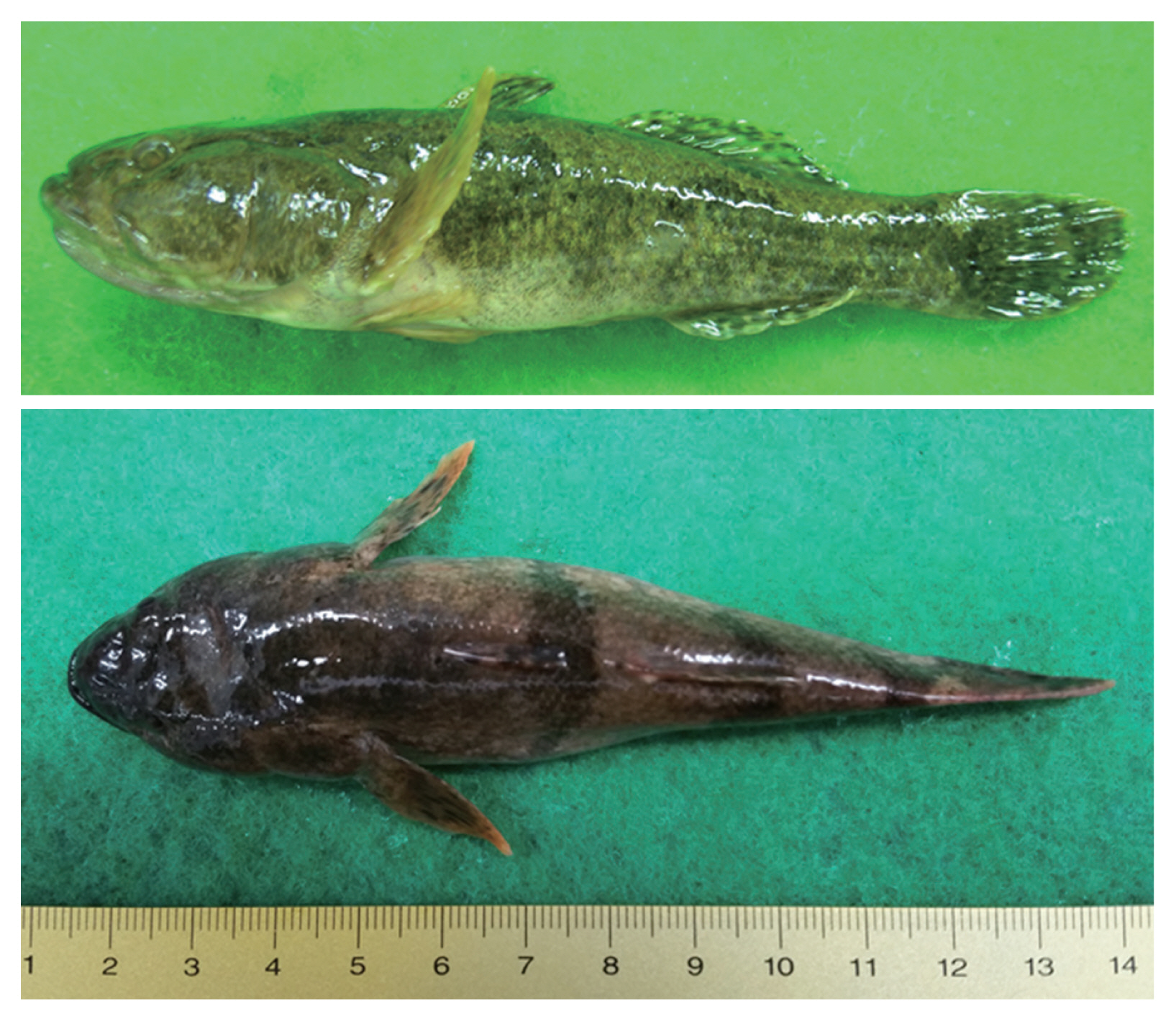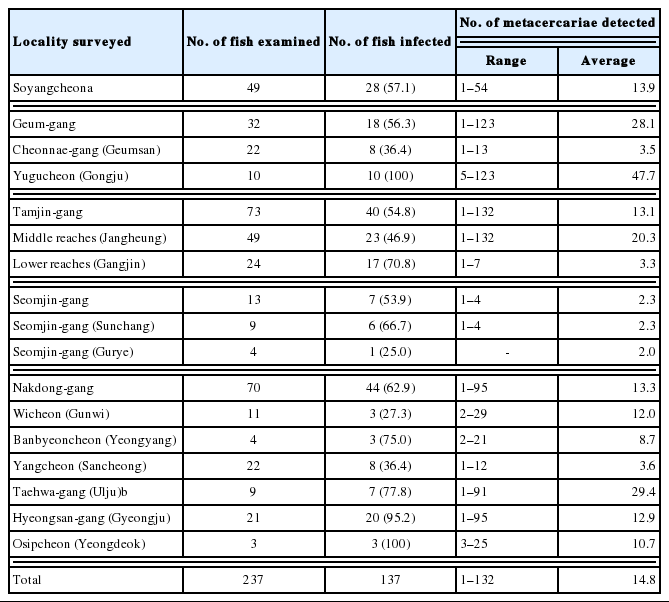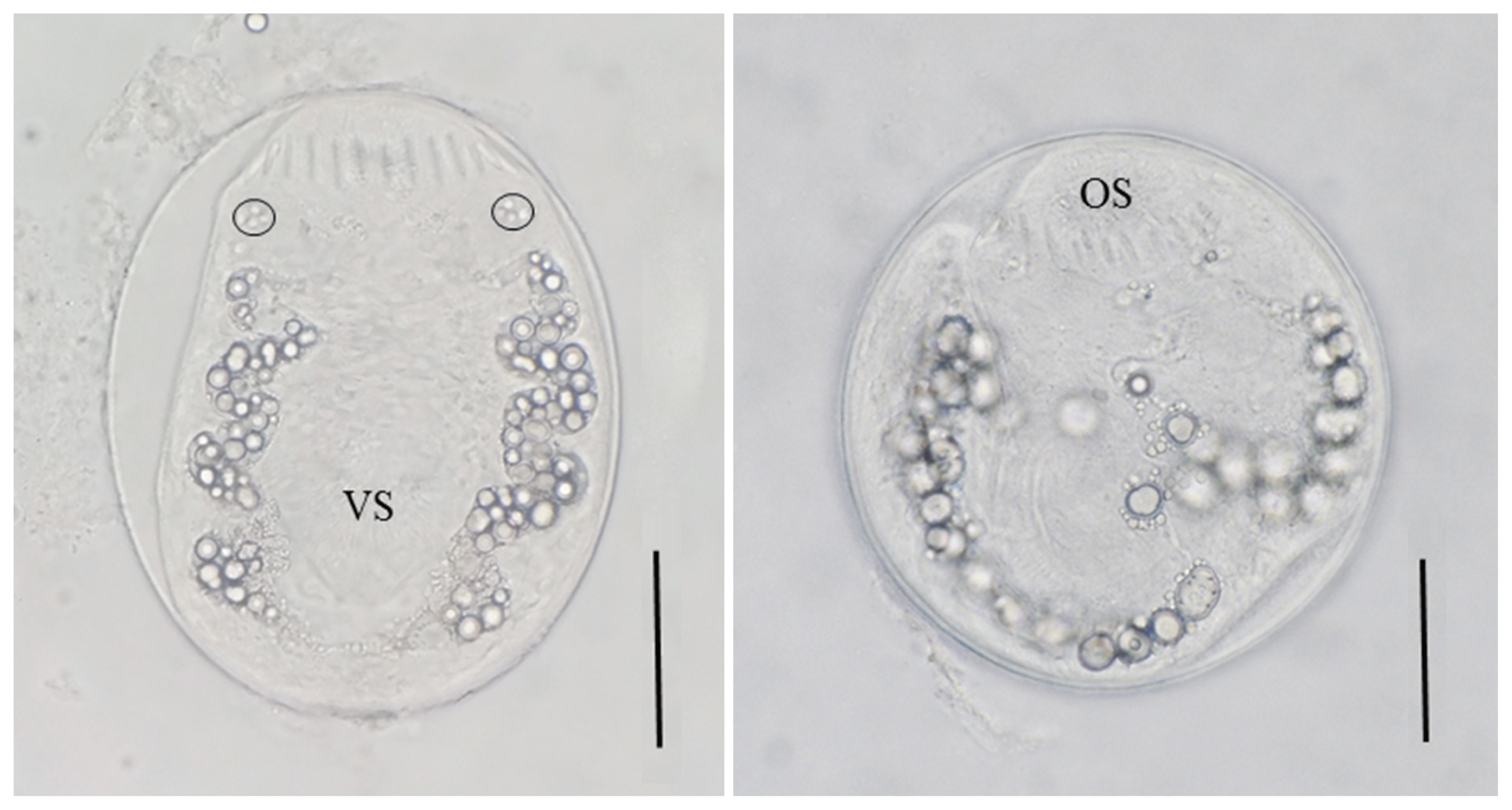Infection Status of Isthmiophora hortensis Metacercariae in Dark Sleepers, Odontobutis Species, from Some Water Systems of the Republic of Korea
Article information
Abstract
Present study was performed to survey on infection status of Isthmiophora hortensis (formerly Echinostoma hortense) metacercariae (IhMc) in dark sleepers, Odontobutis spp., from some water systems of the Republic of Korea. A total of 237 Odontobutis spp. was collected in the water systems of 5 rivers, i.e., Mangyeong-gang (gang means river), Geum- gang, Tamjin-gang, Seomjin-gang, and Nakdong-gang. They were all examined with artificial digestion method for 5 years (2013–2017). A total of 137 (57.8%) Odontobutis spp. were infected with 14.8 IhMc in average. The prevalence was the highest in Nakdong-gang areas (62.9%) and followed by in Mangyeong-gang (57.1%), Geum-gang (56.3%), Tamjingang (54.8%), and Seomjin-gang (53.9%) areas. Metacercarial densities were 28.1 (Geum-gang), 13.9 (Mangyeong-gang), 13.3 (Nakdong-gang), 13.1 (Tamjin-gang), and 2.3 (Seomjin-gang) per infected fish. Especially, in case of Yugucheon (cheon means stream), a branch of Geum-gang, IhMc were detected in all fish (100%) examined and their density was about 48 per fish. By the present study, it was confirmed that the infection status of IhMc is more or less different by the surveyed areas and the dark sleepers, Odontobutis spp., are suitable fish hosts of I. hortensis.
Isthmiophora hortensis (Digenea: Echinostomatidae) was redescribed by Kostadinova and Gibson [1] with a new combination from originally described as Echinostoma hortense in Japan [2]. Kostadinova and Gibson [1] clarified the validity of genus Isthmiophora, which had long been in the obscure taxonomic position in relation to the genus Euparyphium and additionally made a differential key to the species of Isthmiophora with the morphological characteristics of related worm samples. To support the taxonomic validity of this fluke, Sohn et al. [3] made the differential indices with variety of worm samples from the Republic of Korea (Korea). Since the original description from rats in Japan, this species of echinostome has been discovered in rats, dogs, cats, weasels, raccoons, striped field mice, a raccoon dog and a wild boar, which were naturally infected in Korea, Japan, China and Vietnam [3–12]. Human infections with this fluke were also reported in Japan, Korea and China [13–19]. Especially in Korea, this echinostome is a dominant species with clinical importance [20–28].
Several species of freshwater fishes, i.e., Misgurnus anguillicaudatus, Misgurnus mizolepis, Odontobutis obscura interrupta (O. interrupta), Moroco oxycephalus (Rhynchocypris oxycephalus), Coreoperca kawamebari and Squalidus coreanus (S. japonicus coreanus), yellowfin goby, Acanthogobius flavimanus, and tadpoles of Rana nigromaculata were reported as the second intermediate hosts and/or the source of human infection in Korea. Most of these reports were performed in limited areas and with small number of animals [29–35]. Therefore, we examined the dark sleepers, Odontobutis spp., broadly collected from 13 sites in 5 rivers, i.e., Mangyeong-gang, Geum-gang, Tamjin-gang, Seomjin- gang and Nakdong-gang, of Korea.
Total 237 Odontobutis spp. were collected from 13 sites in 5 rivers, i.e., Mangyeong-gang (n=49), Geum-gang (n=32), Tamjin-gang (n=73), Seomjin-gang (n=13) and Nakdong-gang (n=70), and examined all with the artificial digestion method for 5 years (2013–2017) (Fig. 1). The number of fish examined by the surveyed sites was detailedly revealed in Table 1.

Two dark sleepers, Odontobutis interrupta, from Yugucheon in Gongju-si, Chungcheongnam-do, and Wicheon in Gunwi- gun, Gyeongsangbuk-do. The second intermediate host of I. hortensis identified in this study.

Infection status of Isthmiophora hortensis metacercariae in dark sleepers, Odontobutis spp., from some water systems of Korea
The metacercariae of I. hortensis (IhMc) were globular or elliptical, 143–165 (154) by 128–158 (144) μm in size, and have a double layered cyst wall, 27 collar spines including 4 end group ones in each side of the head crown, a ventral sucker transversely elliptical, 2-fold as larger as the oral sucker, and granules in the excretory bladder arranged in 2 rows of tube (Fig. 2).

Two metacercariae of I. hortensis collected from Korean dark sleeper, O. platycephala. They characteristically have an oral sucker (OS), ventral sucker (VS), 27 collar spines including 4 end group ones (encircled) in each side of the head crown and granules in the excretory bladder arranged in 2 rows of tube. Scale bar is 50 μm.
A total of 137 (57.8%) Odontobutis spp. were infected with 14.8 IhMc in average. The prevalence was most high in Nakdong- gang areas (62.9%) and followed by it in Mangyeong-gang (57.1%), Geum-gang (56.3%), Tamjin-gang (54.8%) and Seomjin-gang (53.9%) areas. Metacercarial densities were 28.1 in Geum-gang, 13.9 in Mangyeong-gang, 13.3 in Nakdong-gang, 13.1 in Tamjin-gang and 2.3 per fish infected in Seomjin-gang respectively. Especially, in case of Yugucheon, a branch of Geumgang, IhMc were detected in all fish (100%) examined and their density was about 48 per fish. The infection status with IhMc in fish from 13 surveyed sites was detailedly designated in Table 1.
In the present study, it was confirmed that 2 species of dark sleepers, O. platycephala, and O. interrupta, are suitable fish hosts of I. hortensis although the infection status of IhMc is more or less different by the surveyed areas. Moreover, the prevalences and metacercarial densities of this study were much higher than those of previous studies. Ahn et al. [30] detected total 32 IhMc in 10 (27.8%) out of 36 dark sleepers, O. interrupta, from Seom-gang, a branch of Namhan-gang, in Wonseong-gun (gun=county), Gangwon-do (do=province). Ahn and Ryang [22] also detected IhMc in 4 (22.2%) out of 18 dark sleepers from Namhan-gang. Lee et al. [23] found IhMc in only 1 (2.3%) out of 44 dark sleepers from Cheongsong- gun, Gyeongsangbuk-do. Ryang [20] detected IhMc in 11 (20.3%) out of 54 dark sleepers from Chungju-ho (ho means lake) and the upper streams of Namhan-gang. In case of suitable fish host, muddy loach (Misgurnus anguillicaudatus), Chai et al. [29] reported that total 64 (41.6%) out of 154 loaches were infected with 1–29 (8.1 in average) IhMc per fish infected. Ahn and Ryang [22] detected IhMc in 106 (34.1%) out of 311 loaches from Namhan-gang. Lee et al. [23] found IhMc in 2 (10.5%) out of 19 loaches from Cheongsong-gun, Gyeongsangbuk- do. Ryang [20] detected IhMc in 30 (40.5%) out of 74 loaches from Chungju-ho and the upper streams of Namhan- gang. In another fish hosts of I. hortensis, M. mizolepis, R. oxycephalus, C. kawamebari, S. japonicus coreanus and A. flavimanus, small number of IhMc were detected in Korea [29–35].
Some endemic foci of I. hortensis infections have been reported in Korea [20–23]. Especially in the villages of Cheongsong- gun in Gyeongsangbuk-do, 59 (22.4%) out of 263 residents were positive with echinostome eggs and 1–649 (51 in average) adult worms of I. hortensis were collected from 35 egg-positive cases in the worm recovery after praziquantel treatment and MgSO4 purgation. As the source of human infections, the dark sleeper is most convincing among the second intermediate hosts in these endemic areas. It has been known that residents in inland of Korea frequently eat raw flesh of freshwater fishes such as Mandarin fish (Siniperca scherzeri), Korean aucha perch (Coreoperca herzi) and dark sleepers (O. platycephala and O. interrupta) [20–23,30]. These fishes are powerful predators in the ecosystems of freshwater and presently eaten in raw by residents living in riverside areas of Korea. Therefore, Korean peoples pay attention to the raw consumption of dark sleepers, Odontobutis spp., to prevent the infections with this species of echinostomid fluke.
ACKNOWLEDGMENTS
This study was supported by an anti-communicable diseases control program, 2013-0171 (Studies on the biological resources of human infecting trematodes and their larval infections in intermediate hosts), 2014-E54002-00 (Investigation of fish-borne parasites and acquisition of their biological resources in the southern regions of Korea) and 2015-E54001-00 (Investigation of fish-borne parasites and acquisition of their biological resources in the easthern regions of Korea) of National Institute of Health (NIH), Korea Centers for Disease Control and Prevention (KCDCP). We thank Jung-A Kim and Hee-Joo Kim (Department of Parasitology and Tropical Medicine, Gyeongsang National University College of Medicine, Jinju, Korea), for their help in the examination of fish.
Notes
CONFLICT OF INTEREST
The authors declare that they have no conflict of interest with this article.